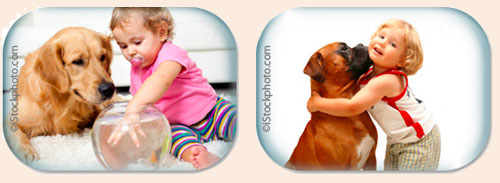Many people think of their dogs as practice for having children, but the arrival of a baby in a household with a dog can pose unexpected problems. A dog may find the baby and your new routines disorienting, even threatening. Keeping the baby safe and the dog happy requires training your dog to realize the baby is neither a threat nor a toy.

“While some dogs are anti-kid, many dogs tolerate kids well,” says Yvonne DiVita, cofounder of the BlogPaws social media site and conference. “The key is to be aware—always be aware. Both baby and dog need your attention. Don’t sacrifice one for the other. The two can become good friends, as long as you show them how to treat each other with care and respect.”
Safety First
Current science is not to treat a new baby as the “alpha,” having power over the family dog, say animal behavior consultants.
“The notion that you should establish a dominant hierarchy between the dog and anyone, let alone a baby, is incredibly dangerous,” warns Debbie Jacobs, CPDT-KA, CPA2, Brattleboro, Vt., author of A Guide to Living with and Training a Fearful Dog and owner of fearfuldogs.com. “The number one goal is for the dog to have positive associations with the baby so the dog is less fearful and less likely to be aggressive. Most dogs are willing to accommodate.”
“Alpha is so 1980s,” says Dusty Rainbolt, ACCBC, Dallas, Texas, a member of the International Association of Animal Behavior Consultants and vice-president ofAdoptAShelter.com.
“It is not science based; it’s based on old research and with wolves, not dogs. The thing you should do is prepare the dog for the sights, sounds, smells and activity levels involved with the baby.”
Jennifer Shryock, CBDC, founder of Family Paws Parent Education, U.S. vice president of Doggone Safe, a member of Pet Professionals and owner of Family Paws LLC, Cary, N.C., also says, “We don’t support the baby as alpha. That is a dangerous position and can put children at risk.”
Shryock recommends acclimating dogs in new routines in “a safe and inclusive way, to start to build the bonds of familiarity.
“We focus on the relationship between parents and dog to work on decreasing attention-seeking behavior. Understand the dog’s learning style because everything associated with the baby is ‘stimulating,’ and come up with a variety of treats and rewards, not just snacks for good behavior such as not jumping, biting or barking.”
Good Moves
Make sure the dog has had obedience training before the baby arrives, Rainbolt urges. “If the dog jumps on people, now is the time to break that habit.”
Rainbolt recommends gradually spending less time with the dog and to “never, ever leave the dog alone with the baby—even a small dog or one that’s used to babies.”
Get the dog used to new routines such as holding a doll while doing dishes, and use food puzzles to get the dog involved with something other than the baby, Rainbolt says.
Rainbolt and the Humane Society of the United States suggest putting baby lotion, oil or powder on your hands to accustom the dog to those scents.
However, Shryock disagrees. “A light doesn’t go off in the dog’s head saying, ‘That’s a baby,’ so don’t sprinkle stuff all over the house. After all, if guests are coming to visit, you don’t ask them to send their underwear ahead of time!”
Instead, Shryock suggests letting the dog “come close, within reason, and sniff the baby’s foot, then move on. Set boundaries, teach good manners and reinforce calm behavior.”
The Humane Society of the United States suggests, among other tips:
- Consult an animal behavior specialist, and train the dog out of any behavior that could become dangerous.
- Put a gate or screen in the doorway of the baby’s room, so the dog gets used to being kept out of the room and can see what’s going on but not get in the way of nursing or changing the baby.
- Discourage the dog from jumping into your lap uninvited.
- Get your dog a check-up from your veterinarian, and make sure vaccinations are up to date.
- Have the dog spayed or neutered, which reduces problems with reproductive issues and makes the dog calm and less inclined to bite.
- Playing recorded baby noises, pushing a swing, and inviting friends with babies are some things you can do, to accustom your dog to new sounds, movements and behaviors.
- On homecoming day, let someone else bring in the baby while you greet and pamper your dog for a few minutes.
- Maintain familiar routines—walking, feeding, playing, cage times and toys—and take the dog along on the leash when walking the baby in the stroller.
Getting It right
The key to introducing your dog to your baby is simple: Be safe, use common sense and check with the experts beforehand.
By Ruth E. Thaler-Carter

